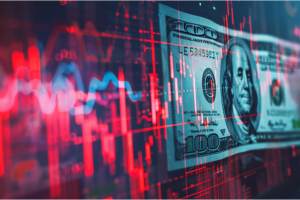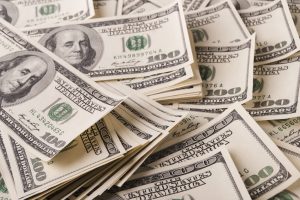
The S&P approaches its all-time high … the bullishness is broadening … reader feedback about a potential recession … return of The Technochasm … bitcoin looks ready to pop
Don’t look now, but the S&P is only 5% below its all-time high.

However, a lot has been made about the uneven gains so far this year.
As we’ve pointed out here in the Digest, the Big Tech/AI trade has exploded. And given the heavy weighting of these stocks in the S&P, their gains have hoisted the returns of the broad market. This has masked the underwhelming performance of the average stock in the S&P.
Well, we’re seeing the gains begin to broaden.
Within the S&P, the percentage of stocks now above their 50-day moving average (MA) is 84%. Even if we look at stocks trading above their longer-term 200-day MA, that percentage comes in at 73%. Both percentages are encouraging.
Meanwhile, there’s positive momentum on the S&P’s Advance/Decline Line. For anyone less familiar, this is a breadth indicator that looks at the difference between the number of stocks rising versus those falling. It heads higher when advances exceed declines.
As you can see below, it’s making new all-time highs.

Finally, there’s the New Highs/New Lows Indicator. As the name suggests, it compares the number of stocks hitting new 52-week highs to those falling to new 52-week lows.
As you can see, it appears we’re on the cusp of edging out the high from February.

Bottom line: The bullishness is broadening.
Yes, there’s the inverted yield curve… yes, data suggest the U.S. consumer is running on fumes … yes, elevated interest rates will continue to dry up credit… yes, the risk of a recession still lingers…
But here and now, stocks want to go up. So, as we’ve been saying in the Digest, trade it while the trading’s good.
Speaking of recessions, earlier this week, we asked readers their take on whether we’ll fall into a recession
Thanks to everyone who wrote in. We love getting these reader perspectives.
While there were good points made for, and against, a recession, here’s one perspective I found especially interesting. Thanks to Patty B. for sharing these thoughts:
First, I tend to believe the Yield Curve isn’t relevant right now simply because the Fed is manipulating Bond prices and yields in order to scare people.
My Blue-Collar intuition tells me the most important factors in the economy right now are inflation, interest rates, and AI. The stickiness of core CPE leads me to think we’ll see elevated rates for longer than expected. In turn, the end of ZIRP combined with AI will probably lead to a lot of Creative Destruction.
And rather than a recession or a Rising Tide, we’ll see a Volatile, Zero-Sum, K-Shaped economy and market. In other word, we’ll have a boom and bust at the same time.
Those who choose stocks wisely— and watch their stops—will prosper. Those who Buy and Hold a classic diversified portfolio will suffer. Thanks for listening.
I believe there’s wisdom in Patty’s perspective – especially the idea of a K-shaped economy/market, which echoes our frequently-referenced idea that the market isn’t a big monolith that rises and falls in unison. Rather, it’s made up of thousands of different stocks with wildly different fortunes and fates.
It reminds me of what long-time Digest readers will remember as the “Technochasm.”
To what extent will AI create a K-shaped economy and stock market?
The Technochasm was our macro expert Eric Fry’s term to describe the stark — and expanding — wealth gap in the United States that’s, in large part, driven by technology.
How much wider will this chasm be with the introduction of Artificial Intelligence (AI)? And not just in the stock market, but as Patty pointed out, for the economy as well?
To what extent will AI eliminate certain jobs, funneling those cost savings to the small group of upper-level managers who watch their net worths explode?
By extension, if you invest in those companies, how much more will your net worth grow compared to investors who don’t align their portfolios with this AI-advantage?
Earlier this spring, we highlighted an illustration of this stark Technochasm-divide with the student education company Chegg. Following a downbeat earnings report, Chegg’s CEO admitted that ChatGPT was negatively influencing its business. The stock imploded 48% in a single day and hasn’t recovered since.
Meanwhile, take Nvidia, the poster child for AI. It has soared this spring based on astonishing demand for its AI-enabling semiconductor chips.
Here’s a comparison of Chegg versus Nvidia since late-April. Chegg is down 50% while Nvidia is up 76%.
And that cavernous expanse between them?
That’s the Technochasm.

Now, yes, as we pointed out at the beginning of this Digest, we are seeing today’s bullishness widen across an increasing number of stocks. But there’s an enormous difference between investors broadening their market exposure and the sustained outperformance of a company fueled by AI-technology.
Bottom line: The Technochasm is very real and will only widen from here thanks to AI. Make sure you’re on the right side of it. To better understand exactly how to do that, check out Eric’s research video on the Technochasm right here.
Thanks again to Patty for the feedback.
Finally, with a huge black cloud clearing above the crypto sector, Luke Lango is eyeing a buying spree
Bitcoin got off to an explosive start in 2023, erupting about 85% by mid-April. This strength paved the way for some monster gains from various altcoins, such as Solana, which tacked on 160% gains by late-February.
But then SEC Chair/super-hawk Gary Gensler decided to attack the industry.
Here’s our crypto expert and the editor of Ultimate Crypto, Luke Lango, with what happened – and more importantly, how the situation is playing out:
In late May, a major risk emerged to the boom cycle thesis when the U.S. SEC brought down the regulatory hammer and chased a few key market-makers out of the industry.
Liquidity got crushed, and cryptos suffered.
In our opinion, this risk has been fully resolved, and the boom cycle is back “on.”
One of the bullish developments that gives Luke confidence in this assessment is the recent wave of spot Bitcoin ETF filings. One, it shows that institutional interest isn’t flagging despite Gensler’s hawkishness. Two, as Luke points it, this all but ensures a huge increase in crypto liquidity.
Back to Luke:
One – if not multiple – of these ETF filings will be approved. When approved, a Bitcoin ETF will dramatically increase the amount of money flowing into the crypto industry.
Just consider this fun fact: In its storied history, BlackRock (BLK) has filed for 550 funds. All but one of them have been approved. That’s a 99.8% success rate.
We like those odds.
Inevitably, one of these Bitcoin ETF filings will get approved. And when it starts trading, a ton of money will flow into it and, by extension, the whole crypto industry.
The other massively bullish sector news arrived yesterday with a key legal victory
A judge in the Southern District of New York ruled that the altcoin Ripple (XRP) is “not necessarily a security on its face.”
This is a major win for the crypto sector in the face of Gensler’s recent attacks.
Here’s how Chris Martin, head of research at the crypto shop Amberdata puts it:
By judging that XRP is not a security we’re starting to get clarity on what constitutes a security and what constitutes a commodity — the SEC will have to revise their tactics on several of their ongoing cases and I expect that this judgment will implicate several other tokens as non-securities.
The immediate impact is we saw a price breakout in bitcoin last night as the crypto pushed north through $31,000.
When we look at its chart here in 2023, we saw an ascending triangle pattern, and it appears it’s trying to break out after consolidating all spring.

Given that bitcoin’s market performance continues to lead the way for the rest of the sector, if this breakout continues, Luke believes we’ll see broadening bullishness from top-tier altcoins. And this has him looking to add new coins to his portfolio in preparation.
Bottom line: If it’s been a while since you’ve thought about crypto, give it a fresh look as the sector appears poised for a new leg higher. And to join Luke in Ultimate Crypto to learn which altcoins he’s adding to the portfolio, click here.
Here’s Luke to take us out:
We have re-strengthened conviction in our Fourth Crypto Boom Cycle thesis, and as a result, we are preparing to go on a crypto shopping spree very soon.
We have previously discussed the various reasons this looks and feels a lot like the start of a new boom cycle for cryptos, including the depth and length of the previous bear market crash, the price action on the breakout, the price of BTC relative to key on-chain metrics, the halving event in early 2024, and more.
All the dots have connected, if you will, in a manner that suggests this is the start of a multi-year bull run in cryptos…
The fundamental and technical outlook for the crypto markets has become increasingly bullish.
It’s time to buy.
Have a good evening,
Jeff Remsburg




